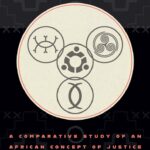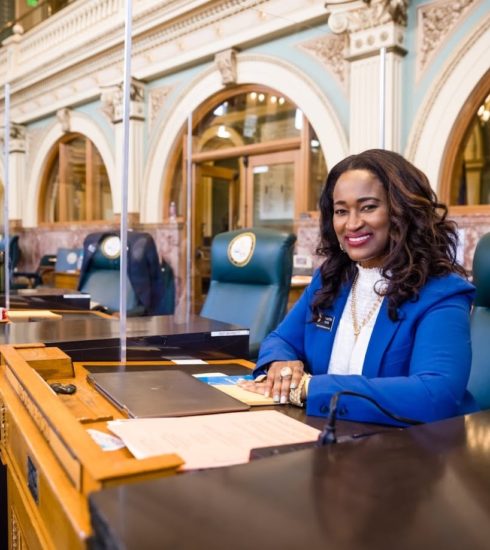As part of the celebrations for Women’s History Month, Afrik Digest Magazine is celebrating women who fought and stood their ground so that those who came after them could live the life and enjoy the freedom they never got to experience.
The campaign to win passage of the 19th Amendment guaranteeing women the right to vote stands as one of the most significant and wide-ranging moments of political mobilization in all of American history. Among other outcomes, it produced the largest one-time increase in voters ever. As important as the goal of suffrage was, the struggle was always far broader than just the franchise, and it spoke to fundamental questions about women’s roles in politics and modern life.
Women gained the right to vote in 1920 with the passage of the 19th Amendment. On Election Day in 1920, millions of American women exercised this right for the first time. But for almost 100 years, women (and men) had been fighting for women’s suffrage: They had made speeches, signed petitions, marched in parades and argued over and over again that women, like men, deserved all of the rights and responsibilities of citizenship. The leaders of this campaign—women like Susan B. Anthony, Alice Paul, Elizabeth Cady Stanton, Lucy Stone and Ida B. Wells—did not always agree with one another, but each was committed to the enfranchisement of all American women.
After the passage of the 19th Amendment in 1920, women of color were often kept from the polls through a variety of tactics. They faced racial and ethnic discrimination and were often discouraged from voting via violence.
This piece takes a look at five women out of the many who made possible the modern right for women to vote!
Ida B. Wells
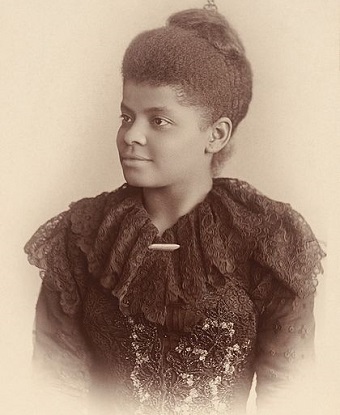
Portrait of Ida B. Wells, ca. 1893. Credit: National Library Archives
Ida B. Wells was an African American civil rights advocate, journalist, and feminist. Wells was born enslaved in Holly Springs, Mississippi in 1862. She was the oldest daughter of James and Lizzie Wells. During Reconstruction, her parents were active in the Republican Party. Mr. Wells was involved with the Freedman’s Aid Society and helped start Rust College. Rust is an historically black liberal arts college. It is affiliated with the United Methodist Church and was one of 10 Historic Black Colleges and Universities founded before 1869 that are still operating.
Wells attended Rust College to receive her early education, but was forced to drop out. At 16, Wells lost both parents and one of her siblings in a yellow fever outbreak. She convinced a nearby school administrator that she was 18, and landed a job as a teacher to take care of her siblings.
In 1882, Wells moved with her sisters to Memphis, Tennessee to live with their aunt. Her brothers found work as carpentry apprentices, and for a time Wells continued her education at Fisk University in Nashville. While on a train ride from Memphis to Nashville in May 1884, Wells reached a turning point. She had bought a first-class ticket, but the train crew forced her to move to the car for African Americans. Wells refused on principle, before being forcibly removed from the train. As she was being removed, she bit one of the crew members. Wells sued the railroad, and won a $500 settlement in a circuit case court. The decision was overturned by the Tennessee Supreme Court.
Following this incident, Wells began writing about issues of race and politics in the South. Using the name “Iola”, Wells had a number of her articles published in black newspapers and periodicals. She later became an owner of two newspapers: The Memphis Free Speech and Headlight and Free Speech. In addition to working as a journalist and publisher, Wells worked as a teacher in a segregated public school in Memphis. She was a vocal critic of the condition of segregated schools in the city, and was fired from her job in 1891 because of her criticism.
In 1892, Wells turned her attention to anti-lynching after a friend and two of his business associates were murdered. Tom Moss, Calvin McDowell, and Will Stewart started a grocery store, which drew customers away from a white-owned store in the neighborhood. The white store owner and his supporters clashed with Moss, McDowell, and Stewart on multiple occasions. One night they had to guard their store against an attack, and ended up shooting several of the white men. They were arrested, and taken to jail. Unfortunately, they did not have a chance to defend themselves. A lynch mob took them from their cells and murdered them. Wells wrote articles decrying the lynching and risked her own life traveling the south to gather information on other lynchings. One of her editorials pushed some of the city’s whites over the edge. A mob stormed her newspaper office and destroyed all of her equipment. Wells was in New York at the time of the incident, which likely saved her life. She stayed in the North after her life was threatened and wrote an in-depth report on lynching in America for the New York Age. This was a newspaper run by T. Thomas Fortune, a former slave.
She brought her anti-lynching campaign to the White House in 1898 and called for President McKinley to make reforms.
In 1895, Wells married Ferdinand Barnett, with whom she had four children. Despite being married, Wells was one of the first American women to keep her maiden name.
In 1896, Wells formed several civil rights organizations, including the National Association of Colored Women. After brutal attacks on the African American community in Springfield, Illinois in 1908, Wells took action. In 1909, she attended a conference for an organization that would later become the National Association for the Advancement of Colored People (NAACP). Though she is considered a founder of the NAACP, Wells cut ties with the organization because she felt that in its infancy it lacked action-based initiatives.
Wells was an active fighter for woman suffrage, particularly for Black women. On January 30, 1913 Wells founded the Alpha Suffrage Club in Chicago. The club organized women in the city to elect candidates who would best serve the Black community. As president of the club, Wells was invited to march in the 1913 Suffrage Parade in Washington, DC along with dozens of other club members. Organizers, afraid of offending Southern white suffragists, asked women of color to march at the back of the parade. Wells refused, and stood on the parade sidelines until the Chicago contingent of white women passed, at which point she joined the march. The rest of the Suffrage Club contingent marched at the back of the parade. Work done by Wells and the Alpha Suffrage Club played a crucial role in the victory of woman suffrage in Illinois on June 25, 1913 with the passage of the Illinois Equal Suffrage Act.
Wells died of kidney disease on March 25, 1931 in Chicago. She left behind a legacy of social and political activism.
In 2020, Ida B. Wells was awarded a post-humous Pulitzer Prize “for her outstanding and courageous reporting on the horrific and vicious violence against African Americans during the era of lynching.”
Ida B. Wells is associated with the Ida B. Wells-Barnett House. It is located at 3624 S. Martin Luther King Dr. in Chicago– it is a private residence and not open to the public. It was listed as a National Historic Landmark on May 30, 1974.
Mary Church Terrell
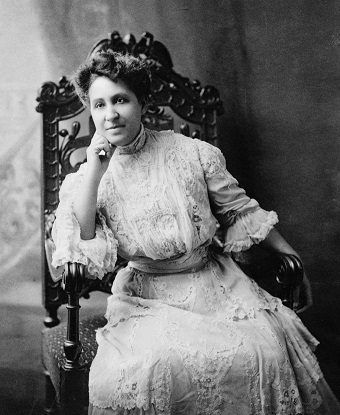
Mary Church Terrell, circa 1880s-1890s. Credit: National Library Archives
Mary Church Terrell was born in Memphis, TN in 1863 to formerly enslaved parents. Despite their bondage, her parents became successful business owners. As a result, they could afford to send their daughter to college. Terrell received her Bachelor’s and Master’s degrees from Oberlin College in Ohio.
Terrell moved to Washington, DC in 1887 and she taught at the M Street School, later known as Paul Laurence Dunbar High School. Her involvement in the early civil rights movement began in 1892 when her friend was lynched by a white mob in Memphis, TN. Along with Ida B. Wells, Terrell brought attention to the atrocity of lynching.
She was also dedicated to racial uplift. Terrell believed that African Americans would be accepted by white society if they received education and job training. She hoped that if black men and women were seen as successful, they would not be discriminated against. She dedicated herself to educating and helping other African Americans. In addition to serving as president of the National Association of Colored Women, Terrell also supported the black woman’s right to vote. She even picketed the White House demanding women’s suffrage.
Terrell also worked to end discriminatory practices of restaurants in Washington, DC. In the early 1870s, DC passed anti-discrimination laws. Places such as restaurants could not turn away customers due to the color of their skin. But by the 1890s, African Americans were once again being banned from public places. Terrell launched a campaign to reinstate anti-discrimination laws. On February 28, 1950, she and several colleagues entered a segregated Thompson Restaurant. When they were refused service, they promptly filed a lawsuit. Terrell targeted other restaurants, this time using tactics such as boycotts, picketing, and sit-ins. In 1953, the court ruled that segregated eating places in Washington, DC, were unconstitutional.
Terrell helped achieve many civil rights gains during her lifetime. Her home at 326 T Street, N.W. stands as a reminder of her tireless advocacy.
Sojourner Truth
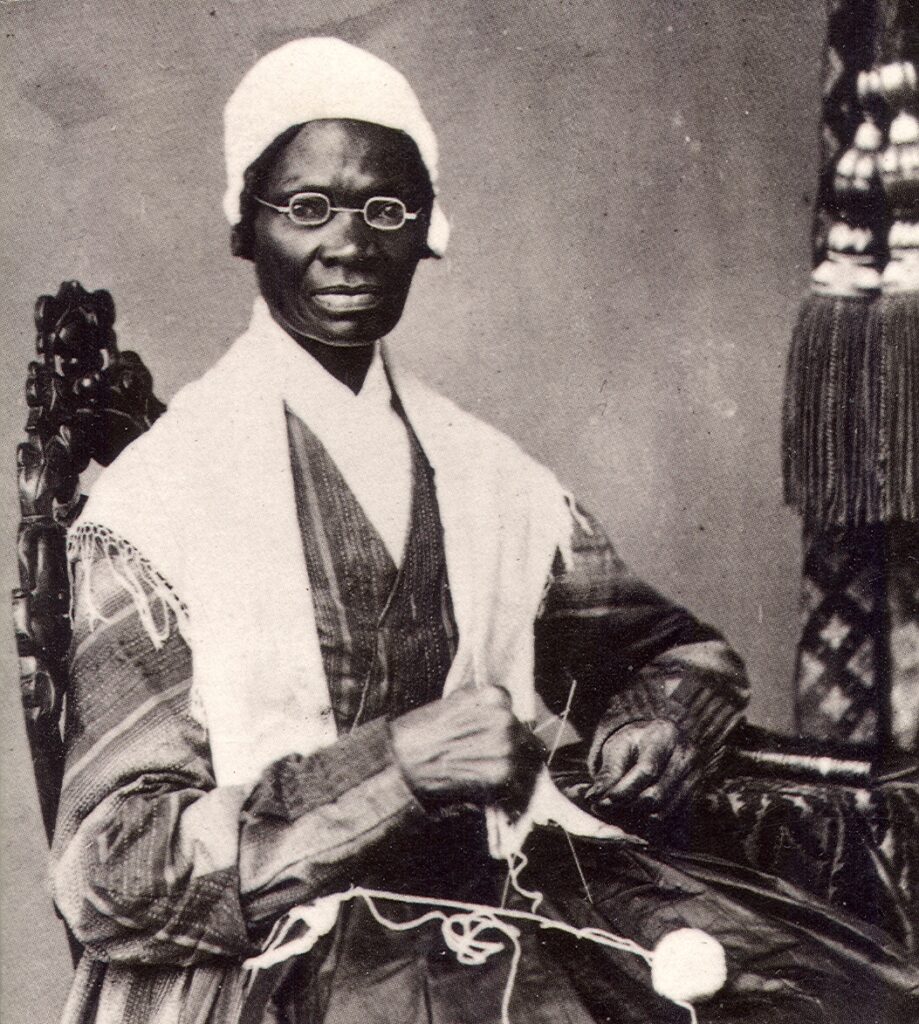
Sojourner Truth. Credit: Wikipedia
Sojourner Truth was born Isabella Baumfree in 1797 in Ulster County, New York, the daughter of James and Elizabeth Baumfree. Together with her parents, she spent her childhood enslaved on the estate of Johannes, then later Charles, Hardenbergh. Enslaved by Dutch settlers, Dutch was her first language. When she was nine years old, she was sold away from her parents to John Neely near Kingston, New York. He purchased her and a flock of sheep for $100. Baumfree remained at John Neely’s until 1808, when she was sold to tavern keeper Martinus Schryver of Port Ewen, New York, where she stayed for 18 months. In 1810, she was sold to John Dumont, of West Park, New York. She remained his property until 1826, when she escaped to freedom.
While at the Dumonts, Baumfree experienced tension and harassment from John’s wife, Elizabeth and rape by John. In 1815 Baumfree met and fell in love with Robert, an enslaved man from a neighboring farm. Robert’s owner forbade the relationship, and beat Robert to death for meeting Baumfree against his wishes. Some years later, Baumfree married an older enslaved man named Thomas. She had had two children prior to Thomas – her first child, James, died in childhood. Her second, Diana, was the result of a rape by John Dumont. She had her last three children, Peter, Elizabeth, and Sophia, with Thomas.
In 1799, New York State passed a law for gradual abolition of slavery. After July 4, 1799, children born to enslaved women were, by legal definition, free, but required to work for their mother’s owner until they were in their twenties (28 for males, and 25 for females). Those born before July 4, 1799 were redefined by law as indentured servants. In reality, they continued to be enslaved for life. An 1817 law declared that all slaves in the State born before July 4, 1799 would become free on July 4, 1827. John Dumont promised to emancipate Baumfree before this final date of emancipation. In 1826, he changed his mind. So, before the year ended, Baumfree freed herself and her infant daughter Sophia. She was not able to bring the rest of her family with her, and would later work to emancipate Peter after Dumont sold him south to Alabama in defiance of the law. Baumfree and her daughter found refuge at the home of Isaac and Maria Van Wagenen in New Paltz, New York. To keep her safe, the Van Wagenens paid Dumont $20 for her labor until emancipation day, July 4, 1827.
While staying with the Van Wagenens, Baumfree’s focus shifted to finding her son Peter. With the assistance of her hosts, Baumfree brought her son’s case to a legal hearing at court. The drawn out process of finding Peter and fighting to bring him back home ended in 1828, when the court ruled in her favor and Peter returned to New York.
It was while with the Van Wagenens that Baumfree experienced a religious awakening, becoming a devout Christian. In 1829, she and Peter left New Paltz and moved to New York City. Baumfree worked as a housekeeper in the city, and at one point was accused of poisoning and stealing from one of her employers. She was acquitted of both charges. In 1839, Peter took a job on a whaling ship. Although Baumfree received letters from her son during his journeys, when the ship returned to New York in 1842, Peter was not on board. She never heard from him again.
In 1843, Baumfree became a Methodist. Called by God to leave the city and “testify the hope that was in her ” across the countryside, she took the name Sojourner Truth and began touring the country speaking against slavery. In 1844, she moved to Northampton, Massachusetts, and joined the Northampton Association of Education and Industry. Founded by abolitionists, this utopian community was a stop on the Underground Railroad; its members supported women’s rights, religious tolerance, and pacifism. It was in Northampton that she met William Lloyd Garrison and Frederick Douglass. After the Association disbanded in 1846, Truth remained in western Massachusetts and began dictating her memoirs to her friend Olive Gilbert. In 1850 her book, The Narrative of Sojourner Truth: a Northern Slave was published by Garrison; she bought a house in Northampton, and spoke at the first National Women’s Rights Convention in Worcester, Massachusetts. She paid off her home just three years later, in part by selling photographs of herself captioned, “I sell the shadow to support the substance.”
In May 1851, she attended the Ohio Women’s Rights Convention in Akron, where she delivered her speech “Ain’t I a Woman?”, one of the most famous speeches on African American and women’s rights in American history. For most of her remaining life, Truth continued to travel the United States to speak on matters relating to the rights of African Americans and women, including the right to vote.
In 1857, Truth moved to Harmonia, Michigan, where she had friends and where her daughter Elizabeth lived. She later moved to Battle Creek. During the Civil War, Truth helped recruit African American men for the Union Army. Her grandson, James Caldwell, enlisted in the 54th Massachusetts Regiment. In 1864, she worked for the National Freedmen’s Relief Association in Washington, D.C., where she met President Abraham Lincoln. While in Washington, she traveled on public streetcars in support of their desegregation.
Truth continued to advocate and lobby pressure for the needs of African Americans. Starting in 1870, she advocated securing land grants from the federal government for former enslaved people, which was an unsuccessful effort. As part of this work, she met President Ulysses S. Grant in the White House. In 1872, she returned to Battle Creek and worked on Grant’s re-election campaign. She went to the polls on Election Day to vote but was turned away.
Although her health was in its decline, she continued to travel and speak. She died in her Battle Creek home on November 26, 1883 at age 86. She was buried in Battle Creek’s Oak Hill Cemetery. In her life, she tirelessly advocated for the rights of African Americans, women, and for numerous reform causes including prison reform and against capital punishment. She is memorialized in countless art works, murals, and statues. She provided the namesake for the 1997 NASA Mars Pathfinder robot Sojourner, and for the asteroid 249521 Truth. In 2009, Truth became the first Black woman memorialized with a bust in the U.S. Capitol.
Mary McLeod Bethune
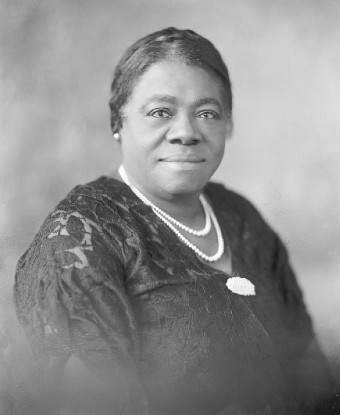
Mary McLeod Bethune. Credit: National Library Archives
Mary McLeod Bethune became one of the most celebrated African American figures of the New Deal era and extended her influence as an educator, civil rights activist, and advocate for women’s equality for more than three decades from the 1920s to the 1950s. Born near Mayesville, South Carolina, July 10, 1875, she was the 15th of 17 children of former slaves who had purchased a small farm after the Civil War. Through the influence of her parents, Samuel and Patsy (McIntosh) McLeod, as well as her own self-determination, she raised herself from the position of a member of a cotton farming family to become an internationally known figure.
At a time when African Americans rarely attained advanced education due to discriminatory practices, Mary McLeod attended the recently opened Trinity Presbyterian Mission School in Mayesville from 1882 to 1886. Aided by a scholarship and the encouragement of her mentor, Emma Wilson, she attended Scotia Seminary for Negro Girls (later Barber-Scotia College) in Concord, North Carolina, a missionary outpost of northern Presbyterians that emphasized religious instruction and industrial education. At Scotia, she completed the high school program in 1892 and the Normal and Scientific Course two years later. Although she attended the Bible Institute for Home and Foreign Missions (later the Moody Bible Institute) in Chicago, Illinois, during 1894-95 with plans to become a missionary, she was refused a commission to serve in Africa by the Presbyterian Mission Board.
Disappointed by this turn of events, Mary McLeod returned to South Carolina and began her first teaching job at the Trinity Presbyterian Mission School in Mayesville, where she had once been a student. Shortly thereafter, the Presbyterian board appointed her to a teaching position at Haines Normal and Industrial Institute in Augusta, Georgia. There she worked with Lucy Craft Laney, the dynamic black founder and principal of the school, with whom she had previously become acquainted and who would become Mary McLeod’s model for serving others. During the 1896-97 school year, she organized the Mission Sabbath School for 275 of the city’s poorest children. After a year, she transferred to teach at the Kindell Institute in Sumter, South Carolina (1897-98). Following her marriage to Albertus Bethune, a former teacher but then a menswear salesman, in May 1898, the Bethunes moved to Savannah, Georgia, to further his business career. Their only child, Albert McLeod Bethune, was born the following year. Later in 1899, the family relocated to Palatka, Florida, where Mrs. Bethune established a Presbyterian missionary school. Albertus Bethune did not share his wife’s missionary ardor, however, and they separated. (Albertus would die of tuberculosis in 1918.)
After five years of teaching and administering the school in Palatka, Mrs. Bethune’s lifelong ambition to build a school for African American girls in the South led her to Daytona Beach, Florida, where, in October 1904, the Daytona Educational and Industrial Institute opened with Bethune as its president. The school, patterned after the Scotia Seminary, was opened in a rented house with six students—five girls and her own son. As a result of her business and organizing skills, the assistance of the black community, and the largesse of some prominent white philanthropists vacationing in Florida, such as James M. Gamble and John D. Rockefeller, Mrs. Bethune’s school grew from a small elementary school to incorporate a high school under the banner of the Daytona Normal and Industrial Institute in 1918. Like most other African American institutions of the period, the school stressed religion, secretarial work, homemaking, and industrial education, with emphasis on agriculture and animal husbandry in tandem with academics; the school had a farm that focused on the production and handling of food products to meet the school’s needs and to provide income. By April 1920, 47 girls had completed the full high school course, and 10, having completed the institution’s teacher training program, were teaching in Florida’s public schools.
In 1923 Mrs. Bethune’s school merged with Cookman Institute, a Jacksonville, Florida, Methodist Episcopal Church college for men, to become the Daytona-Cookman Collegiate Institute with 42 faculty members and nearly 800 students. Six years later, the school’s name was changed to Bethune-Cookman College in recognition of the important role that Mrs. Bethune had played in the school’s growth and development. In 1932 the institution received regional accreditation as a junior college, and in 1936 the high school department was discontinued. In 1943, the college began conferring degrees in teacher education upon its first four-year graduates. Bethune would serve as the college’s president (1932-42, 1946-47) and as president-emeritus, trustee, and chairman of its advisory board (1946-55).
As an educator in the South, Mrs. Bethune had concerns that extended beyond campus life. In the absence of a municipally supported medical facility for African Americans, the Daytona school, under her guidance, maintained a hospital for African Americans from 1911 to 1927. During much of this period, she also operated the Tomoka Mission Schools for the children of black families working the Florida turpentine camps. Ignoring threats made by members of the Ku Klux Klan, she organized a black female voter registration drive in Florida in September 1920 following adoption of the 19th Amendment to the Constitution. As a delegate to the first meeting of the Southern Conference for Human Welfare, she voiced her opposition to degrading southern racial customs.
While directing the Daytona school, Mrs. Bethune gained national prominence through her work with the National Association of Colored Women. From 1917 to 1925 she served as president of the Florida Federation of Colored Women’s Clubs, which opened a rehabilitative home for “wayward” and delinquent girls in Ocala in September 1921. In 1920 she founded and became president of a regional association, which became the Southeastern Federation of Colored Women’s Clubs. One of the major triumphs of this organization was supplying leadership for the women’s general committee of the regional Commission on Interracial Cooperation headquartered in Atlanta.
During 1923-24, Bethune served as president of the National Association of Teachers in Colored Schools, a professional organization of black teachers from mostly southern states.
In 1924 Mrs. Bethune’s work culminated in her election to the presidency of the National Association of Colored Women, an office regarded by many as the highest to which an African American woman could then aspire. During her tenure in this position, she directed the organization increasingly beyond itself to the broader social issues confronting American society. As president of the National Association of Colored Women, Bethune attended meetings of the National Council of Women of the United States. This organization provided her with expanded contacts throughout American society. In 1925 this council of 38 organizations—37 white and one African American—was the avenue for the association’s participation in the International Council of Women at its quinquennial conference, which attracted representatives from 35 countries to Washington, DC. During her four years as head of the association, Bethune emphasized efficient management and developing a presence in national and international affairs and continued the organization’s commitment to a scholarship fund and to the preservation of the Frederick Douglass home in the nation’s capital as a national memorial.
Mrs. Bethune also worked aggressively to project a positive image of African American women to whites through her travels in the United States and abroad. By her oratory and her example she inspired African American women to greater levels of service. Most important, however, she strengthened the structure of the 10,000-member National Association of Colored Women by revising its constitution, improving the association’s periodical, National Notes, and promoting greater communication between members. Through a strenuous financial campaign, she succeeded in establishing the association’s first permanent national headquarters at 1114 O Street in Washington, DC, in 1928, and employing its first paid executive secretary.
During the 1920s, Mrs. Bethune began to develop a national presence as a result of her appointment to the National Child Welfare Commission by Presidents Calvin Coolidge and Herbert Hoover. The latter invited her to a White House conference in 1930 and appointed her to the Commission of Home Building and Home Ownership in 1931.
Beginning in 1935, Mrs. Bethune’s growing prominence was recognized by a number of honorary degrees and distinguished awards. During a 15-year period she would receive honorary doctoral degrees from eight colleges and universities. In addition, she was awarded the distinguished Joel E. Spingarn Medal by the National Association for the Advancement of Colored People in 1935, the Francis A. Drexel Award by Xavier University in 1937, and the Thomas Jefferson Award by the Southern Conference for Human Welfare in 1942.
On December 5, 1935, in New York City, Dr. Bethune, along with 20 other African American women representing 14 black women’s organizations, established the National Council of Negro Women (NCNW) to unite African American w omen in social planning and action on national and international levels around such issues as education, employment, health, housing, civil rights, and international relations.
Although she remained active in the National Association of Colored Women, she had come to believe that its member federations and clubs were not sufficiently involved in local matters and were instead overly oriented toward self-help, thus preventing the association from speaking as the authoritative national voice that black women needed. Eloquently, she wrote:
The great need for uniting the effort of our women kept weighing upon my mind. I could not free myself from the sense of loss, of wasted strength, sustained by the national community through failure to harness the great power of women into a force for constructive action. I could not rest until our women had met this challenge.
Dr. Bethune propelled the National Council of Negro Women to the forefront of the country’s women’s race organizations through its “Conference on Governmental Cooperation in the Approach to the Problems of Negro Women and Children,” held on April 4, 1938, at the Department of the Interior and the White House. The 1938 conference revealed her basic strategy for racial advancement, which was to win policy-making and management positions in government for competent African American women. This emphasis upon upper-level employment was designed to benefit the black masses.
Forceful and articulate, Dr. Bethune was a natural leader and concerned herself with improving the status of all African Americans regardless of socioeconomic position or gender. Among other positions, she served as vice president of the Commission on Interracial Cooperation (1934), president of the Association for the Study of Negro Life and History (1936-52), and vice president of the Southern Conference for Human Welfare (1938-48). Her support was important to the ongoing work of the National Urban League and the National Association for the Advancement of Colored People, serving as a vice president of both civil rights organizations for many years.
Dr. Bethune’s most significant influence as an African American leader came, however, through her role in the administration of President Franklin D. Roosevelt. It was she who primarily educated Eleanor Roosevelt, whom Bethune had met in 1927 through her work with the National Association of Colored Women, on the problems of African Americans in the United States. She was one of several African Americans who had direct access to the White House, providing her with a unique opportunity to personally urge the president to advance civil rights and promote African American interests.
Dr. Bethune left her position in the government when the National Youth Administration ceased operations in 1944, and she resigned as president of the National Council of Negro Women in 1949 to retire to her home on the Bethune-Cookman College campus in Daytona Beach. This two-story, white frame residence, which had been constructed as her residence on the campus in 1914, would be designated a national historic landmark on December 2, 1974.
During her retirement, she remained active in the nation’s political life, receiving many honors as an African American leader. In 1951, for instance, President Harry S. Truman appointer her to his Committee of Twelve for National Defense. That same year, she became president of the Central Life Insurance Company of Florida, which she had helped found in the 1920s to provide insurance for African Americans in the state. In January 1952, she traveled to Liberia as an official U.S. representative to the second inaugural of President William V.S. Tubman. While there, she received that nation’s coveted Star of Africa Aware. In April of that year, the Board of Education of Englewood, New Jersey, canceled her engagement to speak in a public school because the House Committee on Un-American Activities has branded her a communist during the “red-baiting” years of the McCarthy era. A groundswell of public support, however, eventually made possible her appearance at the school.
In 1953 Bethune established the Mary McLeod Bethune Foundation as a nonprofit corporation to promote her social and educational ideals. Undaunted, she continued to champion democratic values and faith in the American creed until she died at her home as the result of a heart attack on May 18, 1955, at the age of 79. One of the South’s most well-known and prominent women, she was buried on a mound overlooking the campus of Bethune-Cookman College.
Sarah J. Garnet
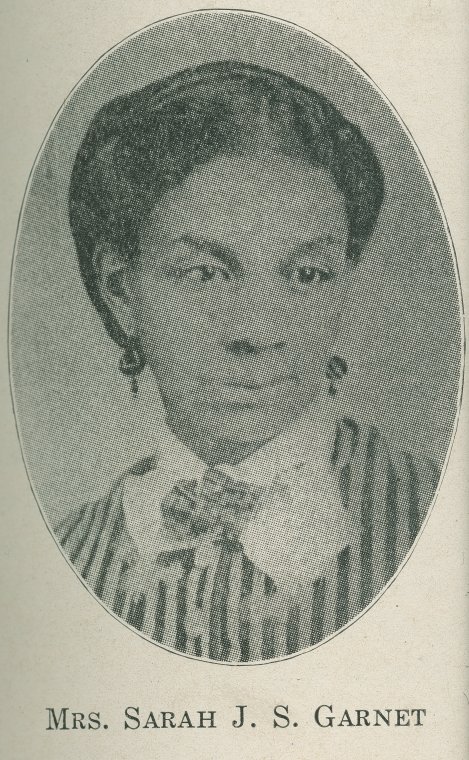
Sarah J. Garnet. Credit: New York public library
Sarah Jane Smith Thompson Garnet is best known as the first Black female principal of a New York City public school. She was equally active in the suffrage movement. Like other Black suffragists, she pursued women’s voting rights as part of a broad vision of justice and equality for Black people. Black suffragists saw the ballot as one piece of a fight for civil rights, education, economic power, and an end to segregation and racist violence.
Garnet was born Sarah Jane Smith in Brooklyn in 1831. Her parents Sylvanus and Annie Springstead were prosperous farmers who made sure their eleven children got good educations. By age fourteen, Sarah Smith was a successful student and classroom monitor. She taught in Williamsburg, Brooklyn and then became principal of an integrated school in Manhattan. Garnet was the first Black woman principal in the city’s public school system.
Garnet was also a prominent leader in the Black women’s club movement. She founded the Equal Suffrage League, a suffrage club for Black women, in Brooklyn in 1902. The League met in Garnet’s home or in a nearby YMCA on Carlton Avenue in Fort Greene, at the time a middle-class Black neighborhood. Black men as well as women attended many of the meetings. In 1907, the Equal Suffrage League invited Anne Cobden-Sanderson to speak. Cobden-Sanderson was the first British suffrage leader to visit the United States. The British movement would become more and more influential in the United States over the next few years.
Garnet also worked to support Ida B. Wells’s anti-lynching campaign and to end discrimination against Black teachers. She was an early member of the National Association of Colored Women (NACW), going on to head its Suffrage Department. Alongside leaders like Wells, Josephine St. Pierre Ruffin, Victoria Earle Matthews, and Mary Church Terrell, Garnet connected the women’s ballot to a broader agenda of racial uplift and equal rights.
The Equal Suffrage League and New York’s white-dominated suffrage organizations did work together. But white suffragists’ racism limited the extent of interracial cooperation. In 1910, for example, Garnet met with wealthy suffragist Alva Belmont. Belmont wanted to set up a “colored” branch of her Political Equality Association. The leaders set up a public meeting, but Black women’s interest wasn’t strong. A newspaper report of the meeting noted that white women’s suffrage speeches “did not evoke much applause.” Black women were already organized for suffrage–they did not need white women to do it for them.
Garnet’s activism extended beyond American borders as well. In 1911, she and her sister Dr. Susan McKinney went to London for the inaugural Universal Races Congress, an early global effort to promote interracial harmony. McKinney, a fellow activist and the first Black woman doctor to be licensed in New York, presented a paper at the meeting. Garnet brought back word of the exciting progress of the suffrage movement in England.
Sarah J. Garnet married twice. In the 1850s she married James Thompson, who died in the late 1860s. (Several sources mistakenly give Thompson’s name as “Tompkins.”) The couple’s two children both died before reaching adulthood. In 1879, she wed the famous abolitionist Henry Highland Garnet. The Garnets apparently separated after a year, and Henry Highland Garnet died in 1882 in Liberia.
Garnet died in her Brooklyn home on September 17, 1911, shortly after returning from London. At her memorial service, speakers included W. E. B. Du Bois and anti-lynching activist Addie Waites Hunton. They remembered Garnet as a teacher, a champion of equal rights, a club woman, a suffragist, and a leader of the “womanhood of her race.” She is buried in Green-Wood Cemetery.
In 2019, a Brooklyn elementary school was renamed “PS9 Sarah Smith Garnet” in her honor.

